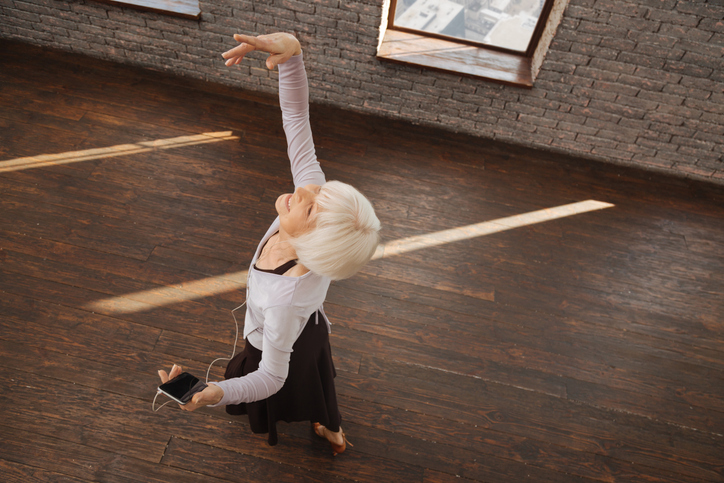Knee osteoarthritis isn’t a matter of wear and tear; it’s a disease that can be managed
By Wendy Haaf
It might start with a niggling stiffness and pain in the knee first thing in the morning or when you’re walking upstairs or getting up after sitting for a while. Or it could initially come on as soreness after walking or an occasional feeling that the knee is giving way while you’re standing or during other weight-bearing activities.
More than four million Canadian adults—roughly one in seven—are living with osteoarthritis (OA), with the knee being the joint most commonly affected. And while it doesn’t affect only those 55 or older (slightly more than half of those with symptomatic knee OA are younger than 65), most new diagnoses each year occur among people aged 55 to 64. In fact, it is believed that about 45 per cent of Canadian adults will develop symptomatic knee OA during their lifetime.
While the condition may be widespread, so are outdated and false beliefs about it, even among people who have been diagnosed with knee OA.
For instance, in a 2019 study of 27 patients at one hospital orthopaedic clinic, most held misinformed ideas about the cause of the disease, its possible consequences, and how activities like exercise affect its symptoms and progression.
Here’s what you need to know about what knee OA is, how to reduce the chances of developing it, and what you can do to mitigate its impact if you already have it.
Understanding OA
“It’s important to go back and redefine what we understand knee osteoarthritis to be, because it was previously not well understood,” says Dr. Tom Appleton, the division head of rheumatology at Western University and St. Joseph’s Health Care London and an associate professor in the Department of Medicine and the Department of Physiology & Pharmacology at Western’s Schulich School of Medicine & Dentistry in London, Ont.
While OA was once thought of as wear and tear affecting the shock- absorbing cartilage in the knee joint, the reality is different and more nuanced. “I like to look at the joint as a whole as being more of an organ,” explains Codie Primeau, a physiotherapist, researcher, and assistant professor at Western’s School of Physiotherapy. And OA’s effects aren’t limited to the cartilage, adds Mohit Kapoor, the co-director of the Schroeder Arthritis Institute (part of Toronto’s University Health Network) and a professor at the University of Toronto. “We now know it’s a wholejoint disease,” he says.
Part of the deepened understanding of OA stems from research proving that “with exercise and other types of joint loading, the joints can repair and resurface and joint tissues can regrow, to a certain extent,” Appleton says. “Physical activity is essential to stimulate the joint organ to repair itself.”
It’s also become clear that while excess weight—a risk factor for knee OA—exerts additional stress across the joint, that’s only part of the story. “Obesity is related to another major risk factor, which is injury to the joint,” says Dr. Lori Albert, a rheumatologist at the Schroeder Arthritis Institute. In addition to increasing the chance of joint trauma, excess weight can change the normal biomechanics of the joint or how the various parts are designed to move together, which also “seems to play an important role in the development of osteoarthritis in the weight-bearing joints,” she adds.
But even stress and biomechanics aren’t the whole story. Excess weight, obesity, and cardiometabolic disorders (conditions such as high blood pressure, high cholesterol, type 2 diabetes, and metabolic syndrome) “are also associated with osteoarthritis in the hand, and obviously you don’t walk on your hand,” Albert says.
What’s the connection? In these systemic conditions, the body produces chemical signals that promote chronic inflammation, which, over time, contributes to damage of joint tissues. Then there’s the fact that when people develop pain, they often become less physically active and consequently “tend to get a lot of muscle weakness,” Albert says. Weaker muscles lead to added abnormal stress across the joint and less stimulation of cartilage repair, resulting in a cycle of “worsening pain, worsening weakness in the muscle, and worsening osteoarthritis,” she adds. In other words, “if you’re sedentary, that really accelerates the process of joint damage and the progression and worsening of pain,” Appleton says.
On the other hand, there are steps you can take to both manage knee OA symptoms and improve your knee health.
What You Can Do
First, if you’ve been experiencing symptoms such as frequent knee pain and stiffness that can’t be explained by a recent injury, talk to your primary-care provider about getting assessed for knee OA. “Early intervention can make a big difference,” Appleton says. “I’ve seen lots of people who come in at an early stage and do the things they can do to improve their risk factors and have their symptoms go into remission. We don’t cure arthritis of any kind, but we do see better outcomes and symptoms going away or markedly reduced if we can intervene early.”
Appleton suggests that one place to start is by asking your doctor “What cardiometabolic risk factors do I have that could be addressed?” “This is really important because these conditions are potentially preventable and reversible with a lot of interventions, and we’ve seen some exciting emerging studies showing that if you treat metabolic disease, you can improve arthritis outcomes,” he says. (It’s worth noting, however, that this isn’t yet part of day-to-day clinical practice.)
If you’re carrying some excess weight, you can ask for a referral to a registered dietitian, too. While it’s not possible for everyone, losing a modest amount of weight can have a potent effect. “It’s been shown that a five to 10 per cent loss of body weight is associated with an improvement in pain and improved function,” Albert explains. Your doctor may also be able to offer support with another lifestyle factor that can affect OA symptoms. “There’s a lot of literature to suggest that patients with knee OA who are smokers will experience worse knee pain than patients with the same amount of osteoarthritis who are non-smokers,” explains Marsha Alvares, an advanced practice physio- therapist practitioner at the Schroeder Arthritis Institute.
It’s also worth seeing a physiotherapist, if possible, for an individualized assessment. Many people unconsciously “develop abnormal ways of walking, sitting, or standing, or they develop weakness in muscle groups more on one side than the other,” Appleton says. “Physiotherapists are. incredible at identifying those sorts of things” and prescribing targeted exercises to help correct them.
Physiotherapists can also provide guidance on exercises aimed specifically at improving symptoms in the long term and promoting knee health. “The big quadriceps muscle in the thigh is probably the most important muscle for reducing mechanical stress across the knee joint,” Albert says. “Targeted exercises to strengthen the quadriceps can improve pain, improve function, and help prevent OA from progressing.” Growing evidence suggests that regular moderate physical activity, including strength training, also helps reduce systemic inflammation.
One key to success, according to Alvares, is starting slowly and, if necessary, finding ways to modify standard exercises like squats to your current ability level. “Maybe you’re not doing as deep a squat, or maybe you’re using a wall,” she says. “It’s trying to find the part of the exercise that you can start doing that’s non-painful or change an activity a bit to make it less painful so you can do it for longer.”
How long is long enough? “What can you tolerate now?” Alvares asks. “Is it 10 minutes in the morning? Is it walking around your backyard a few times a day? Any movement is better than no movement.” Finding a type of exercise you enjoy and can integrate into your daily life will increase the likelihood you’ll stick with it. “It’s tricky because exercise is one of those things where you don’t usually see immediate benefit,” she says.
More Options
Ideally, an exercise program for OA will include moves that involve standing (which helps train your core muscles) and weight-bearing and foster your ability to do everyday activities. For example, while rowing and aquafit are good for your cardiovascular health, these don’t provide the kind of weight-bearing that stimulates cartilage repair and fosters knee health, Alvares points out.
While it’s unfortunately not covered by provincial health plans, a group exercise program offered by GLA:D Canada ticks all of these boxes. (Some private plans will reimburse the cost, so check your policy if you have extended medical insurance.) “It’s evidence-based and structured, twice a week for six weeks,” Alvares says. “It’s very function-based. We call the exercises neuromuscular exercises because they get you to focus on alignment at the knee and balance.” By the end of the course, “patients often report a 30 per cent improvement in symptoms, and post-GLA:D, they usually have quite substantial functional improvements,” she adds.
Similarly, a 2020 study co-authored by Western University’s Primeau looked at the effects of a 12-week neuromuscular exercise program for knee OA and found that over time, “people were able to work harder—at a higher exercise intensity—while also reducing the amount of pain they were experiencing,” he says. “I think it’s helpful for people to know that they might experience a little bit of an increase in pain [during exercise when starting a program] but that with time, this should go down.”
Other options for group exercise include 50+ classes offered by community centres. If you prefer solo workouts, the Arthritis Society’s website features playlists of arthritis-friendly exercises (arthritis.ca).
And don’t underestimate the power of just putting one foot in front of the other. “Even simple walking is
good for helping with knee pain, and it’s good for helping with stress,” Albert says. She suggests finding a way to incorporate walking into your daily routine. “Plan to go out with your loved one after dinner or with your dog. Lots of people find that getting a dog really helps them to get walking.”
To foster the habit, Albert recommends wearing shoes “that tie up, have a nice cushion, and support your ankles and feet well.” And that goes for inside your home as well as outside. “I strongly urge people to wear good supportive footwear around the house,” she says. “It might be supportive sandals or an indoor pair of running shoes. That can reduce that feeling of fatigue, help improve pain, and be a segue to helping people do more activity.”
In some cases, certain types of aids can make walking and other forms of exercise more comfortable. “If you’re having trouble walking, there’s no shame in using a cane for support until you’re feeling better,” Albert says. Similarly, she adds, hiking poles can provide extra stability. “Anything that’s going to help you do more is important.”
You can also experiment with wearing an inexpensive soft knee brace or sleeve during exercise. The sensation of pressure from the garment can distract from the pain, and compression disperses some of the stress on the joint, which can provide symptom relief, Alvares says. Custom braces, on the other hand, are typically costly, cumbersome to put on, and often uncomfortable to wear, she adds. Consequently, “adherence declines very quickly.”
There is one situation in which a specific type of brace definitely does work. “There are three compartments in the knee—one on the inside, one on the outside, and one underneath the kneecap,” Alvares says. If your OA is most severe in the front of the knee, “a patellar strap brace can offload the kneecap,” she says. “We fit people for them in clinic, and they have an im- mediate change in their symptoms.” (It’s best to consult a physiotherapist to determine whether such a device is appropriate for you, and if so, which type.)
Unlike other varieties, a patellar strap brace can be worn throughout the day. “We often tell patients not to brace all the time, because the muscles around the knee go on vacation when something else is doing their job,” Alvares says, “whereas the patellar strap brace isn’t hindering any muscles: it decreases the pain response in the knee so your muscles can fire a bit better.”
If anything, it’s impossible to overstate how crucial regular physical activity is for managing OA. “If you’renot getting that to stimulate the jointorgan to repair itself, nothing canovercome it,” Appleton emphasizes. The results of heeding that message are worth the effort. “Something I hear again and again from people who have OA knee pain and established OA is that when they are told to exercise, they think ‘What’s the point?’” Albert says. “But it’s truly amazing—after a number of weeks and months, their pain is so much better; they walk better, and they feel better.”






